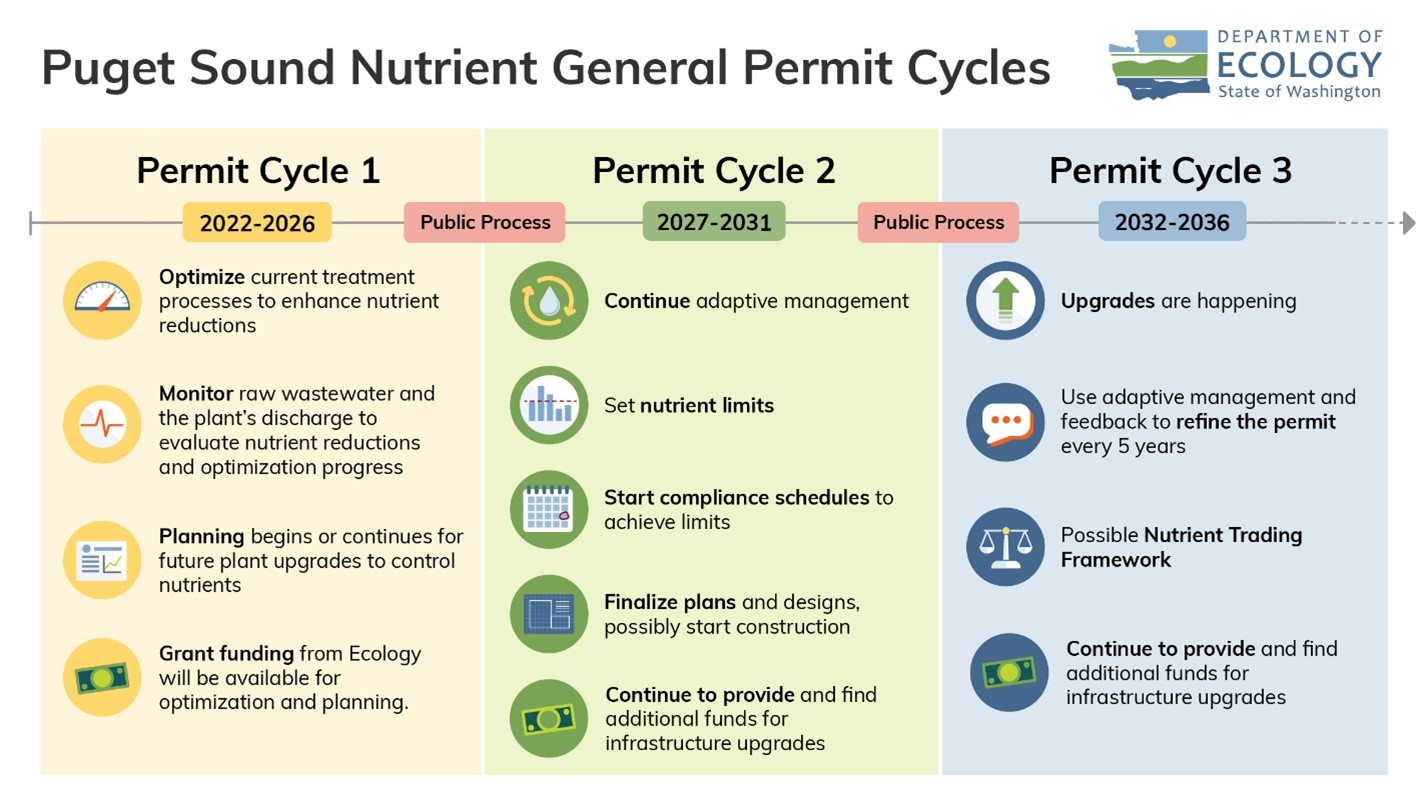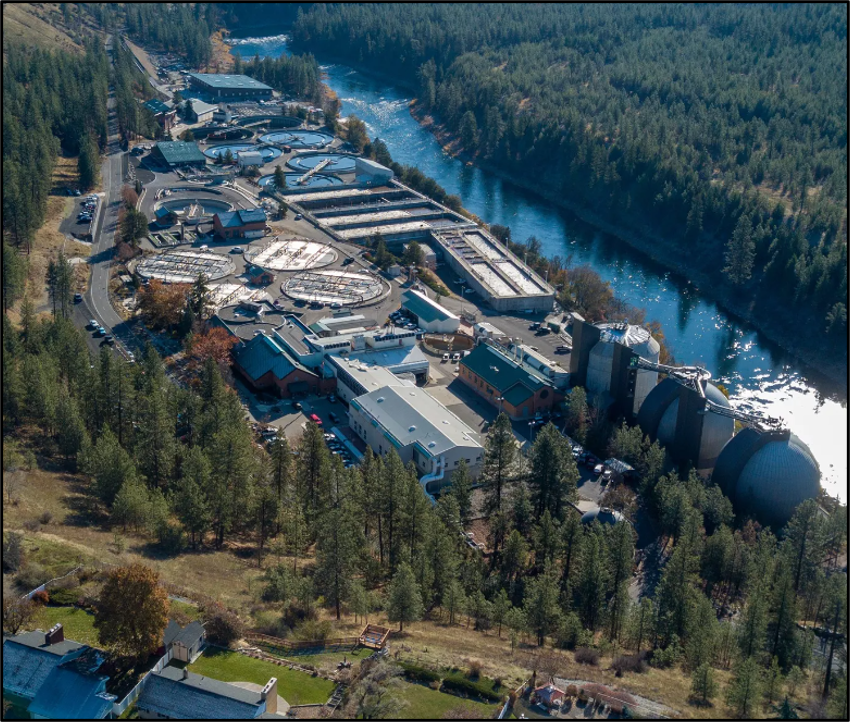Often, we think of nutrients as a good thing. We want nutrient-rich foods, and we may add nutrients like nitrogen or phosphorus to our gardens to help plants grow. Unfortunately, what’s good for our gardens, is a big problem for Puget Sound. Puget Sound is receiving too many nutrients, so much so that it is polluted.
What’s the major source of excess nutrients reaching Puget Sound? People! Even though human waste is treated at wastewater treatment plants, when discharged from these facilities without the use of nutrient treatment, it still contains too much nitrogen.
En Español: Cómo solucionar la contaminación de nitrógeno en Puget Sound
Puget Sound communities, Ecology, and our partners are working to reduce the amount of nutrient pollution in Puget Sound. In the two years since we issued the Puget Sound Nutrient General Permit, we are seeing progress and hearing questions about what’s next to get Puget Sound healthy.
Puget Sound Nutrient General Permit
To address the impacts excess nutrients are having on Puget Sound, Ecology issued the Puget Sound Nutrient General Permit. For the first five years of the Puget Sound Nutrient General Permit, the 58 wastewater treatment facilities covered by the permit are tasked with doing three (very important) things:
- Monitor their nitrogen levels
- Optimize their current systems to reduce nitrogen
- Plan for the future
Facilities are now reporting their nitrogen discharges and optimizing their treatment systems. While there are some legal challenges to this work, the vast majority of the permit is in effect.
Using this permit, we are addressing the largest source of nutrient pollution in Puget Sound. This work is required under federal and state law because it is necessary to improve the health of Puget Sound and the life that depends on it.
By the end of 2025, permittees are required to submit a Financial Capability Assessment to Ecology. More on what that is and why it matters is below. Given this important deadline, we are working on tools that will help permittees complete these financial assessments, including new guidance that will be available this summer. Permittees will then use the results of their assessments to move forward with their facility plans to reduce their nitrogen discharge.
Why are we talking financial capabilities instead of clean water? Because before we can get to a cleaner Puget Sound, many communities will need to make significant investments in treatment technologies at their wastewater treatment plants. Many are already moving ahead, to take advantage of the historic increase in federal funding available through the Bipartisan Infrastructure Law, which is providing additional millions of dollars to help offset costs for local ratepayers. Others are still developing their long-term plans to incorporate new technologies into their wastewater infrastructure.
Planning for nutrient removal
Major upgrades to wastewater treatment facilities don’t happen on a whim. That is why when we issued the general permit in 2021, we provided our vision for what the next 15 years of the permit might look like, to give communities a realistic timeline of when nutrient control technologies will be operational.

Recognizing the critical need for nutrient treatment, the state Legislature appropriated $9 million for a Puget Sound wastewater treatment plant optimization grant program. This money helps facilities to optimize the performance of their existing operations and plan for future upgrades. Permittees are using this grant funding for nutrient monitoring, sampling and analysis, equipment purchases, and consulting services.
As facilities are planning for the upgrades they need to reduce nutrients, they will also have a better idea of how much it will cost. We anticipate that some of Puget Sound wastewater facilities will use the permit requirements as an opportunity to expand their capacity to accommodate population growth, address maintenance issues, and modernize their facilities, while also protecting local waters from many different pollutants. Most facilities in Puget Sound will eventually need to install nutrient treatment systems.
Ecology doesn’t require specific technologies or approaches when it comes to nutrient reduction – we know that every wastewater treatment plant is unique in size, age, and treatment type, so the costs can vary widely. We recognize that reducing nutrient pollution will require significant investments in many communities. Each community will determine the most efficient and effective path to achieve the required nutrient reductions for their facilities. We expect to see most nutrient control technologies operational in 15 - 20 years, which is when we will see the biggest reductions in nutrient pollution.
We will continue to provide funding, technical assistance, and guidance to support communities that are reducing nutrient pollution to help them reduce the burden on their rate payers. We are also considering a nutrient trading program for permittees, which could also help alleviate financial burden.
There are two parts of the Puget Sound Nutrient General Permit that are important to the conversation on how to have both livable communities and a healthy Sound: a financial capability assessment and environmental justice requirements.
What is “financial capability”? And why does it matter here?
Wastewater treatment plants are vital infrastructure for communities, so updating these facilities to meet state and federal requirements needs to be done with the community in mind. Like most infrastructure investments, the improvements facilities need to make to meet nutrient pollution reduction requirements are expensive. A Financial Capability Assessment can help a utility better understand the financial health of the community and avoid negative impacts, such as large rate increases, for their community members who are least able to absorb those increases.
Most wastewater treatment facilities were not designed to effectively control nutrient pollution. This means that in planning to meet permit requirements, they are required to do a financial capability assessment and make upgrades to their facility.
Permittees will use their financial capability assessment to identify an economically reasonable level of treatment, as well as the level of treatment that can meet the state’s Water Pollution Control Act and the federal Clean Water Act. To support this requirement, we are developing guidance for permittees, which builds on the U.S. Environmental Protection Agency’s guidance.
Ecology’s Financial Capability Assessment Guidance will be ready this summer. We are planning workshops on the guidance. To receive updates on the guidance and associated workshops, subscribe to our Puget Sound Nutrient General Permit email list.
Environmental Justice in permitting
Sewer utility rates are paid by the individuals, families, businesses, and industries that make up a community. When the costs of preventing pollution go up, communities have an opportunity to pay for these costs in a way that does not pass on disproportionate impacts to low- to moderate-income households and communities. A sewer bill increase may be equal for everyone but will take a higher percentage of income away from households with lower income.
The permit includes an environmental justice requirement to identify communities served by a wastewater treatment plant that face multiple environmental harms and health impacts and assess ways to mitigate rate impacts related to future investments. This is in addition to the financial capability assessment, as they serve two different purposes.
We encourage all permittees to use the environmental justice analysis to consider more equitable approaches to address affordability concerns for low- to moderate-income households and communities. Many utilities in Washington have customer assistance programs to assist low-income households. Across the country, some utilities have explored ways to move from equal to more equitable rates, including tiered rate structures, fixed vs. variable charges, efficiency-oriented rate design, or usage-based rates.
Planning today for a better tomorrow
While wastewater treatment upgrades are not frequent, they are necessary. In fact, it has been decades since many of the Puget Sound wastewater treatment facilities have upgraded their treatment systems. When the U.S. Clean Water Act passed in 1972, it established new standards for what could be discharged into our nation’s waters. These standards are critical for protecting water quality, aquatic life, and human health. In the 1970s, many of the Puget Sound region’s original wastewater treatment plants only provided physical treatment, or screening out the solids from raw sewage, before discharging. This “primary treatment” was the norm at the time.
Then, as science, technology, and our understanding of the long-term impacts to water quality evolved, new federal requirements meant facilities were upgraded or built to include biological treatment using special microorganisms to consume organic matter. This is often referred to as secondary treatment. Learn about treatment technologies in our focus sheet.
By the late 1980s, many communities in Washington had upgraded their existing facilities or were building new facilities with secondary treatment. However, Puget Sound communities initially were not required to do this due to a “marine waiver” in federal law. Only after Ecology determined that secondary treatment was available and reasonable for all wastewater treatment plants across the state, including marine dischargers, did Puget Sound communities invest in these ‘new’ technologies. This was nearly 40 years ago and the last time major upgrades were required across the region.
At the same time, many communities in the country’s more densely populated east coast were already tackling nutrients. Water bodies like the Long Island Sound and Chesapeake Bay were experiencing hypoxia or “dead zones” where oxygen levels were too low for aquatic life to survive. In response, New York City and other cities and communities along the eastern seaboard made investments specifically to control nutrients. Today, those investments are paying off in better water quality and a healthier marine environment.
Riverside Park Water Reclamation Facility is one of the wastewater treatment plants in the state that has nutrient treatment in place. Photo courtesy of City of Spokane. 
There are wastewater treatment plants in Washington that control nutrients, notably the City of Spokane, Spokane County, Liberty Lake; and, Lacey, Olympia, Tumwater, and Thurston County (LOTT), and a few others – have reduced nutrients to low levels to protect rivers, streams, and Puget Sound. Between effective planning and funding support from state and federal sources, these communities are protecting water quality – while local residents pay wastewater utility rates that are comparable to the rest of the state.
Compared to communities that have already addressed nutrient pollution, most Puget Sound wastewater treatment plants are using older, outdated treatment. But, not for long. Communities in Puget Sound are on their way to reducing nutrient pollution and improving oxygen levels in Puget Sound, and we look forward to continuing to share their progress.

